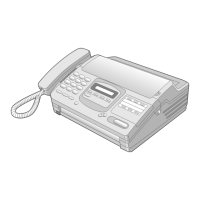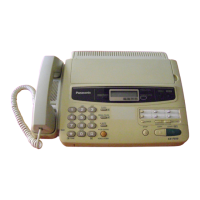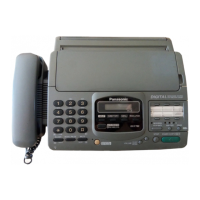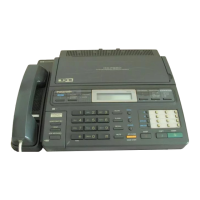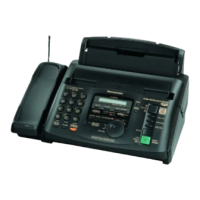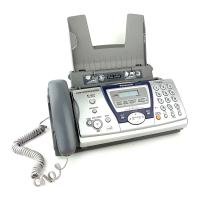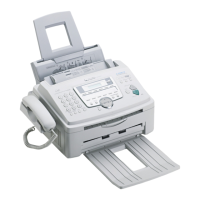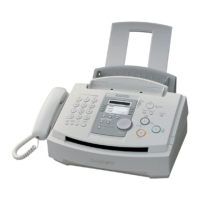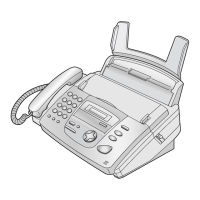Do you have a question about the Panasonic KX-F50 and is the answer not in the manual?
Details FCC registration, Ringer Equivalence Number (REN), and telephone line connection rules.
Guidelines for making test calls to emergency numbers to avoid service disruption.
Warnings against exposure to rain, moisture, fire hazards, and radio frequency energy.
Describes the unit's multi-functionality as a facsimile, answering device, and telephone.
Explains how to switch between telephone and facsimile functions during a call.
Details the three distinct modes (TAD/FAX, FAX, TEL) for receiving calls and documents.
Covers preparing to transmit, transmitting, receiving documents and voice, voice contact, and copying.
Guides on recording outgoing messages, playing back, and managing recorded messages.
Instructions for making calls using the handset or on-hook, and redialing features.
Lists and illustrates all included accessories such as cords, paper, and micro cassette tape.
Provides diagrams and instructions for connecting the AC power, telephone line, and handset.
Illustrates the front, rear, and side views of the unit, labeling controls and jacks.
Explains the function of each button and indicator light on the unit's control panel.
Advises on keeping the unit away from heat, moisture, dust, and electrical noise.
Details how to clean the unit's cabinet and what not to do.
Provides instructions for inserting the tape, ensuring no slack, and proper usage for sound quality.
Step-by-step guide on how to open the cover and load the recording paper roll correctly.
Instructions on how to insert and secure the document tray onto the unit.
Explains how to set the dialing mode (TONE/PULSE) and ringer volume (HIGH/LOW/OFF).
Steps to follow before powering on the unit, and how to switch it on.
Step-by-step guide to record a personal outgoing message up to 16 seconds.
Instructions on how to play back, verify, and re-record the outgoing message.
How to print a list of all programmable functions and their current settings.
Lists various functions that can be programmed, with their codes and default values.
General steps for programming phone numbers for automatic dialing.
Detailed procedure to program a custom logo for fax transmissions.
Provides a table of character codes used for programming the logo.
Step-by-step guide to program the unit's fax telephone number for transmission headers.
Instructions for storing phone numbers for quick dialing using direct call station keys.
Guide to programming phone numbers into 20 speed dial stations (00-19).
How to program phone numbers that will not be printed on lists for privacy.
Steps to remove stored phone numbers from memory.
Instructions on how to list stored phone numbers and write names in the directory.
Details the acceptable paper width, scanning width, and weight for documents.
Specifies the number of sheets and paper weight limits for the ADF.
Lists document types that may cause jamming or poor transmission quality.
Instructions on how to place documents on the tray and adjust guides.
Explains the use of FINE and LIGHT ORIGINAL buttons for image quality.
How to insert documents into the unit for sending.
Steps to dial a number and start transmitting using the START/COPY button.
How to transmit documents using pre-programmed direct call station keys.
Instructions for sending documents exceeding the initial page limit.
How to transmit documents to the last dialed number using the REDIAL button.
Explains the functions of TAD/FAX, FAX, and TEL receiving modes.
How the unit handles incoming calls automatically or requires manual intervention.
Guides on setting the TEL mode and using START/COPY for manual document reception.
How to speak to the other party before or after a fax transmission/reception.
What to do when the other party initiates voice contact during fax operations.
Instructions on how to use the unit to make copies of documents.
Identifies buttons like OGM PLAY, OGM REC, and indicators like CALLS.
Guides on playing back, rewinding, forwarding, and erasing recorded voice messages.
Explains the one-touch message playback and pausing during playback.
Steps to play back to the end of desired messages before new ones are recorded.
How to record a personal voice memo using the MEMO/2WAY button.
Instructions for recording ongoing telephone conversations, with legal disclaimers.
How to listen to incoming messages as they are being recorded.
Basic steps for making calls using the handset.
How to dial numbers without lifting the handset using the MONITOR button.
Explains how to redial the last number manually or with automatic redialing.
How to initiate calls using stored one-touch or speed dial numbers.
Simple instructions on how to answer calls when the unit rings.
Guides on setting polling passwords and initiating polling for document retrieval.
Details setting a 4-digit main password for secure facsimile communication.
Covers retrieving messages and managing the answering device from a remote location.
Explains system settings, printer tests, and general maintenance procedures.
Details FCC registration, Ringer Equivalence Number (REN), and telephone line connection rules.
Guidelines for making test calls to emergency numbers to avoid service disruption.
Warnings against exposure to rain, moisture, fire hazards, and radio frequency energy.
Describes the unit's multi-functionality as a facsimile, answering device, and telephone.
Explains how to switch between telephone and facsimile functions during a call.
Details the three distinct modes (TAD/FAX, FAX, TEL) for receiving calls and documents.
Covers preparing to transmit, transmitting, receiving documents and voice, voice contact, and copying.
Guides on recording outgoing messages, playing back, and managing recorded messages.
Instructions for making calls using the handset or on-hook, and redialing features.
Lists and illustrates all included accessories such as cords, paper, and micro cassette tape.
Provides diagrams and instructions for connecting the AC power, telephone line, and handset.
Illustrates the front, rear, and side views of the unit, labeling controls and jacks.
Explains the function of each button and indicator light on the unit's control panel.
Advises on keeping the unit away from heat, moisture, dust, and electrical noise.
Details how to clean the unit's cabinet and what not to do.
Provides instructions for inserting the tape, ensuring no slack, and proper usage for sound quality.
Step-by-step guide on how to open the cover and load the recording paper roll correctly.
Instructions on how to insert and secure the document tray onto the unit.
Explains how to set the dialing mode (TONE/PULSE) and ringer volume (HIGH/LOW/OFF).
Steps to follow before powering on the unit, and how to switch it on.
Step-by-step guide to record a personal outgoing message up to 16 seconds.
Instructions on how to play back, verify, and re-record the outgoing message.
How to print a list of all programmable functions and their current settings.
Lists various functions that can be programmed, with their codes and default values.
General steps for programming phone numbers for automatic dialing.
Detailed procedure to program a custom logo for fax transmissions.
Provides a table of character codes used for programming the logo.
Step-by-step guide to program the unit's fax telephone number for transmission headers.
Instructions for storing phone numbers for quick dialing using direct call station keys.
Guide to programming phone numbers into 20 speed dial stations (00-19).
How to program phone numbers that will not be printed on lists for privacy.
Steps to remove stored phone numbers from memory.
Instructions on how to list stored phone numbers and write names in the directory.
Details the acceptable paper width, scanning width, and weight for documents.
Specifies the number of sheets and paper weight limits for the ADF.
Lists document types that may cause jamming or poor transmission quality.
Instructions on how to place documents on the tray and adjust guides.
Explains the use of FINE and LIGHT ORIGINAL buttons for image quality.
How to insert documents into the unit for sending.
Steps to dial a number and start transmitting using the START/COPY button.
How to transmit documents using pre-programmed direct call station keys.
Instructions for sending documents exceeding the initial page limit.
How to transmit documents to the last dialed number using the REDIAL button.
Explains the functions of TAD/FAX, FAX, and TEL receiving modes.
How the unit handles incoming calls automatically or requires manual intervention.
Guides on setting the TEL mode and using START/COPY for manual document reception.
How to speak to the other party before or after a fax transmission/reception.
What to do when the other party initiates voice contact during fax operations.
Instructions on how to use the unit to make copies of documents.
Identifies buttons like OGM PLAY, OGM REC, and indicators like CALLS.
Guides on playing back, rewinding, forwarding, and erasing recorded voice messages.
Explains the one-touch message playback and pausing during playback.
Steps to play back to the end of desired messages before new ones are recorded.
How to record a personal voice memo using the MEMO/2WAY button.
Instructions for recording ongoing telephone conversations, with legal disclaimers.
How to listen to incoming messages as they are being recorded.
Basic steps for making calls using the handset.
How to dial numbers without lifting the handset using the MONITOR button.
Explains how to redial the last number manually or with automatic redialing.
How to initiate calls using stored one-touch or speed dial numbers.
Simple instructions on how to answer calls when the unit rings.
Guides on setting polling passwords and initiating polling for document retrieval.
Details setting a 4-digit main password for secure facsimile communication.
Covers retrieving messages and managing the answering device from a remote location.
Explains system settings, printer tests, and general maintenance procedures.
| Type | Plain Paper Fax |
|---|---|
| Modem Speed | 14.4 Kbps |
| Memory | Up to 28 pages |
| Paper Size | A4, Letter |
| Automatic Document Feeder Capacity | 10 sheets |
| Paper Tray Capacity | 50 sheets |
| Printing Method | Thermal Transfer |
| Paper Capacity | 50 sheets |
| Power Supply | 220-240 V AC, 50/60 Hz |
| Transmission Speed | 6 seconds |
| Resolution | 203 x 196 dpi |
| Transmission Time | 6 seconds |
